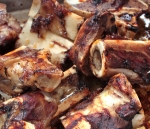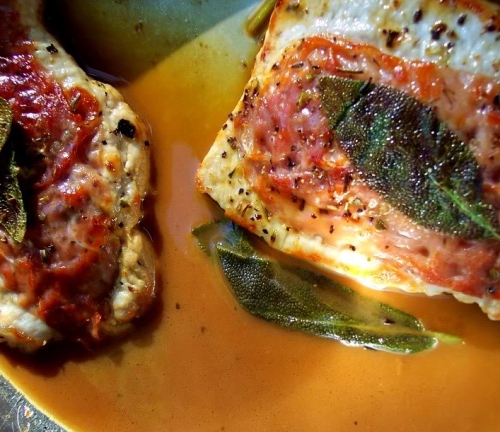Ever since the Fall, no food has sparked more controversy than meat: some eschew it and even more restrict it, but meat, for most people, is what’s for dinner. By meat we mean red meat. The USDA considers all meat from livestock red because they contain more myoglobin (aka “red stuff”) than poultry or fish. For most people, this means beef or pork (yes, “the other white meat” is red), though sheep and goat as well game such as venison—and for that matter, whale—fall into the same category. Beef and pork in their various incarnations constitute a significant portion of our diets. An average American consumes 67 lbs. of beef and 51 lbs. of pork annually, most of it at home, meaning that the majority of people buy meat raw and cook it themselves.
 Most people do this without a great deal of fuss or bother. A cursory glance at the label is often all that the average shopper needs for a selection. But given the expense and importance of meats, care and discrimination is warranted when it comes to their purchase and preparation. A description of meats demands a language of its own, one based on cuts and quality. While the vocabulary of cuts requires a basic knowledge of quadruped anatomy (leg, back, etc.) in addition to an arcane phraseology stitched largely from antique versions of French and English (brisket and loin, for instance), quality descriptions of meats derive from strict, precise government standards imposed by the United States Department of Agriculture.
Most people do this without a great deal of fuss or bother. A cursory glance at the label is often all that the average shopper needs for a selection. But given the expense and importance of meats, care and discrimination is warranted when it comes to their purchase and preparation. A description of meats demands a language of its own, one based on cuts and quality. While the vocabulary of cuts requires a basic knowledge of quadruped anatomy (leg, back, etc.) in addition to an arcane phraseology stitched largely from antique versions of French and English (brisket and loin, for instance), quality descriptions of meats derive from strict, precise government standards imposed by the United States Department of Agriculture.

“I have a few pieces of choice rib eye that I’ve prepared in a display tray with a prime rib eye to educate people in the difference between the marbling. Less than 3% of all beef in the United States rates a prime grading.” Paul says that supermarket chains are not an ideal place to shop for the best cuts of meat. “Most supermarkets aren’t even cutting their own products locally. Kroger, for instance, has most of their meats cut in Cincinnati and then shipped out.” Paul explains that their reasoning behind this is the liability factor in using saws and other cutting instruments in their stores.
The practice of aging beef is another factor contributing to flavor and tenderness. “All of my prime beef is wet aged, vacuum-sealed in a package in its natural juices. Wet packaged beef will have a stamp that tells me how many days it has been aging since the slaughter. Dry aging is a whole different process,” Paul says. ”Humidity and temperature are keys. Every product is out of the bag with no liquid around it, and the enzymes are breaking down the meat, making for a really rich flavor.” Paul explains that quality pork is the product of a nationwide program in which farmers are raising heirloom breeds of swine without using hormones or strong antibiotics. Sometimes referred to as heirloom or heritage breeds, examples in the marketplace today include Berkshire (also known as Kurobuta, meaning “black pig”), Duroc, and Tamworth “There’s an amazing difference in the taste and tenderness between this pork and what you’d find in most supermarkets,” Paul says. .


Then there are marinades and dry rubs. “Marinades flavor and tenderize meat,” Dan says. “A marinade normally incorporates an acid, which is a natural tenderizer, whether the acid is wine or vinegar, lemon juice or lime juice. For a tougher piece of meat you’d want the marinade to penetrate more. But if you’re cooking a rare piece of meat, and the marinade penetrates too far, the acid will cook the meat, and it will soak up the marinade like a sponge, giving the meat a different texture. Dry rubs are another excellent way to flavor meat,” Dan says. “You always want salt and pepper; something with a little heat, like different types of peppers, then some dried herbs like rosemary, oregano or fennel as well as powdered onion, garlic and paprika.” Dan recommends that any cut of meat, once cooked, should rest for a few minutes before carving or cutting.
Pork Saltimbocca
12 oz. pork tenderloin, sliced into 6 medallions and pounded thinly
6 thin slices prosciutto
6 large fresh sage leaves
Dredge pork in all-purpose flour seasoned with salt and black pepper. Arrange 1 prosciutto slice over pork. Top with 1 sage leaf and spear with a wooden pick. Heat about 1/4 cup extra virgin olive oil in a sauté pan, add pork and brown lightly. Remove pork; add about a tablespoon of finely chopped shallots and a teaspoon of garlic. Add about 1/4 cup each white wine and chicken stock to pan, cook until reduced by about half, finish with about a tablespoon unsalted butter. Arrange pork on a warm plate and drizzle with pan juices. Serve immediately.










